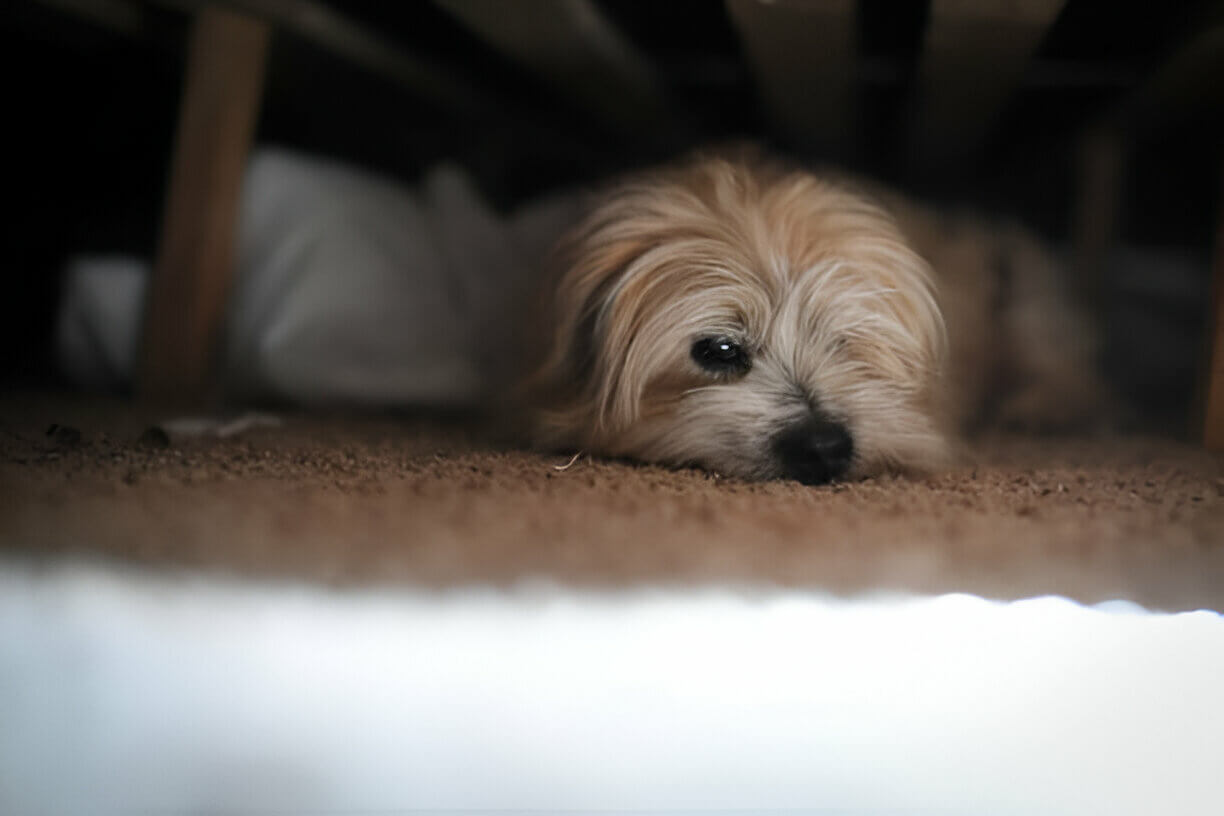Fireworks can be a beautiful spectacle for humans, but they often cause significant distress for dogs. With their acute sense of hearing, the loud noises and bright flashes can trigger intense fear and anxiety. This guide provides comprehensive strategies to block out firework noise and help your dog stay calm during these events.

Understanding Your Dog’s Fear of Fireworks
Signs of Fear
Dogs exhibit various signs of fear and anxiety when exposed to fireworks. These include:
- Whining or Barking: Vocalizing distress through sounds like whining, barking, or growling.
- Clinginess: Seeking comfort by staying close to you or following you around.
- Excessive Panting or Drooling: Anxiety can lead to increased panting, drooling, or lip-licking.
- Hiding: Finding a secluded spot to hide, such as under furniture or in a closet.
- Attempting to Escape: Trying to flee the noise by attempting to run away.
- Trembling or Shaking: Visible shaking or trembling due to fear.
- Pacing or Restlessness: Becoming agitated and constantly moving around.
- Loss of Appetite: Losing interest in food due to stress.
- Dilated Pupils: Wider-than-usual eyes indicating heightened stress.
Recognizing these signs early helps you take steps to comfort your dog and reduce their stress.
Why Are Dogs Afraid?
The loud, unpredictable noises and bright flashes associated with fireworks can trigger a dog’s fight-or-flight response. Unlike other sounds they might be accustomed to, fireworks are sporadic and intense, making them particularly frightening. This response is a natural defense mechanism, but it can cause significant distress for dogs.
Preparing for Fireworks
Create a Safe Space
Creating a safe space for your dog is essential. This can be a quiet room away from windows where the noise is less intense. A basement or a large closet can work well. Equip this area with your dog’s favorite bed, toys, and blankets to make it as comfortable as possible.
If your dog is crate trained, their crate can serve as a secure den. Ensure the space is familiar and cozy to provide a sense of security.
Use White Noise
White noise can be very effective in masking the sound of fireworks. Devices like fans, air conditioners, and air purifiers can help create a steady background noise. There are also specific white noise machines or apps designed to provide a calming auditory environment.
Brown noise, which has a lower frequency, can also be effective. These noises can help drown out the abrupt sounds of fireworks, making them less startling.
Play Music or TV
Playing music or keeping the TV on can help disguise the sound of fireworks. Classical music or specially designed playlists for dogs are particularly soothing. The familiar sounds of the TV can also be comforting and help mask the noise outside. Choose music or TV shows that your dog is accustomed to and enjoys, as familiar sounds can provide additional comfort.
During the Fireworks
Stay Calm and Present
Your presence can be incredibly reassuring for your dog. Stay with them during the fireworks, maintaining a calm and composed demeanor. Use a soothing tone of voice and avoid showing any signs of anxiety yourself, as dogs can pick up on their owner’s emotions. Your calm presence can significantly reduce their stress.
Provide Distractions
Keep your dog engaged with their favorite toys or activities. Puzzle toys filled with treats or peanut butter can keep them occupied and distracted from the noise. Engaging your dog in play can help divert their attention away from the fireworks. Introducing new toys or activities can also capture their interest and keep them focused on something positive.
Use Calming Products
There are various products designed to help calm anxious dogs. Thundershirts, which apply gentle pressure to the dog’s body, can have a calming effect similar to swaddling a baby. Pheromone sprays and diffusers can also create a calming environment.
Additionally, there are natural calming supplements that may help reduce anxiety. Consult with your veterinarian to find the best options for your dog.
Long-Term Solutions
Desensitization
Desensitization involves gradually exposing your dog to the sound of fireworks in a controlled manner. Start by playing recordings of fireworks at a very low volume while engaging your dog in positive activities, such as feeding or playing. Gradually increase the volume over time as your dog becomes more accustomed to the sound.
This method can help reduce your dog’s fear over the long term. Desensitization should be done slowly and carefully to avoid increasing your dog’s anxiety.
Consult Your Veterinarian
For dogs with severe anxiety, consulting a veterinarian is advisable. They can recommend medications or other treatments to help manage your dog’s fear. It’s important to discuss all options with your vet to find the best solution for your pet. Medications should be used as part of a comprehensive plan that includes behavioral strategies and environmental modifications.
Additional Tips
Exercise Beforehand
Giving your dog plenty of exercise before the fireworks start can help tire them out, making them more likely to relax or sleep through the event. Ensure they have had a good walk and some playtime during the day. Physical activity can help reduce anxiety and prepare your dog for a restful evening.
Proper Identification
Ensure your dog has proper identification, such as an updated collar tag and a microchip. This is crucial in case they manage to escape due to fear during the fireworks. Proper identification can help ensure your dog is returned to you quickly if they get lost.
Conclusion
Fireworks can be a challenging time for dogs, but with the right preparation and strategies, you can help minimize their stress and fear. By creating a safe space, using white noise and music, staying calm and present, and considering long-term solutions like desensitization, you can make fireworks less frightening for your furry friend. Remember to consult with your veterinarian for additional advice and support tailored to your dog’s specific needs.



